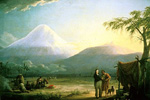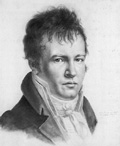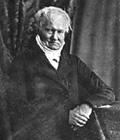
| Alexander von Humboldt
History of Geology |

Born: 14 Sept. 1769, Berlin, Germany.
Died: 6 May 1859, Berlin, Germany.
| Abstract | Introduction |
| New World exploration | Later life |
| Historical assessment | Related websites |

| Alexander von Humboldt
History of Geology |

Born: 14 Sept. 1769, Berlin, Germany.
Died: 6 May 1859, Berlin, Germany.
| Abstract | Introduction |
| New World exploration | Later life |
| Historical assessment | Related websites |
He received a royal passport to explore throughout the Spanish New World Empire in 1799 and embarked on a private 5-year expedition. He eventually visited the Canary Islands, Venezuela, Brazil, Guiana, Cuba, Colombia, Ecuador, Bolivia, Peru, Mexico, and the eastern United States. The next three decades were devoted mainly to writing and publishing a 30-volume report, Voyages de Humboldt et Bonpland 1799-1804 (1805-34). During this time he also wrote Aspects of nature (1808) and Geognostic essay on the trend of rocks in two hemispheres (1822). Among his many geological contributions, he named the Jurassic System.
In 1829 at age 60, Humboldt suddenly had another great opportunity—a whirlwind expedition through Asia, across Russia and Siberia to Mongolia. A modest 3-volume work on Asie Centrale was published as the result several years later. The remainder of his life was consumed in writing his monumental masterpiece, Cosmos, a 5-volume encyclopedia in which he developed the unity of all natural and human phenomena. This last great work of the last great universal man enhanced his reputation enormously as the greatest natural scientist of his day.
Humboldt had an aristocratic birth. He spent much of his childhood at Schloss Tegel, the
family estate 12 miles north of Berlin. He developed an early interest in the natural world
and came to be called the "little apothecary" because of all his rock, insect and flower
collections. Humboldt was exposed to science during his teenage years through contacts with
friends; no formal science instruction was available at that time in Berlin. His older
brother was an excellent student, while Alexander was frail and weak. He seemed to excell
only at painting and had an uncertain future.
In 1789 Alexander joined his brother at Göttingen University, the foremost German
university. There he was exposed to physics, chemistry, geology, and other sciences, in
which he developed lifelong interests. He met Georg Forster, who had participated in Cook's
second circum-navigation of the world (1772). Humboldt and Forster travelled to England in
1790. The trip was a revelation to Humboldt, and next year in revolutionary France he became
a lifelong liberal. Humboldt dedicated his life to exploring the Earth and understanding
nature.
Humboldt applied in 1791 for a position with the Prussian Ministry of Industry and Mines. He
was instructed to complete courses at the Freiburg Academy, a goal he had desired. At that
time, Werner was at the height of his career, which meant a rigorous training for young
Humboldt. In 1792, he was appointed assistant inspector in the Dept. of Mines. The probationary
period was skipped, owing to Humboldt's brillant student career, his aristocratic birth, and
his independent income. Humboldt found himself entirely out of place in the lazy, corrupt
bureaucracy of the Prussian government. Nonetheless, he gained permission to inspect mines in
outlying districts. He was quickly promoted to Chief Inspector because of his thorough reports.
In 1793, Humboldt revitalized the ancient gold mines of the Fichtel Mountain district (in Bavaria near the border with the Czech Republic). This was a spectacular achievement, which included a school for miners, safety equipment, and health
improvements. In 1795 he had a series of promotions and diplomatic assignments. The highest
governmental and scientific positions were within his reach. Meanwhile, he carried out literally
1000s of scientific experiments. He came close to inventing the battery, but failed to
recognize what he had created. He never forgave himself later in life for this one scientific
oversight.
During this period, Humboldt went through a series of incomplete love affairs, both with men and
women. He was apparently ambivalent and unfulfilled in this regard. He remained a lifelong
bachelor totally consumed with his devotion to science, exploration, and knowledge. In 1796,
Humboldt's mother died of cancer leaving a large estate to him. He resigned his post in the
mining department in 1797; he was free at last to follow his ambitions.
Humboldt and Bonplan were granted royal passports to explore throughout the empire. They
departed for South America on June 5, 1799 with the best scientific instruments—sextants,
compasses, telescopes, microscopes, etc. Humboldt was not merely seeking observations,
specimens and measurements; he was embarking on an extraordinary effort to find out
about the unity of nature.
They eventually visited the Canary Islands, Venezuela, Brazil, Cuba, Colombia, Ecuador,
Bolivia, Peru, Mexico, and the eastern United States. They conducted a great amount of
geographical surveying and mapping. They collected geological, zoological, botanical, and
ethnographic specimens, including more than 60,000 rare or new tropical plants.
Humboldt and Bonpland landed at Cumaná to escape a typhoid outbreak on their ship, July
16, 1799. From Caracas they crossed the desolate llanos (plains) where Humboldt conducted
experiments on the dreaded electric eel, a 6- to 9-foot fish that can deliver a shock up to
650 volts. They journeyed by large canoe up the Orinoco River to the "Great Cataracts."
The region of the upper Orinoco was virtually unknown even to the Spanish. It was an
extremely dangerous environment with alligators, jaguars, and swarms of biting insects.
They accomplished an overland portage of seven miles to the Rio Negro of the Amazon system
in Brazil, where the Portugese had a warrant for Humboldt's arrest as a spy.
Near San Carlos, they continued into the legendary "Casiquiare Canal," a unique waterway of
inland delta connecting the Orinoco and Amazon systems. At times they had no food, and
conditions were almost unbearable. This desolate region is little changed today; it is
remote, inhospitable, and undeveloped. At Esmeralda, Humboldt observed the manufacture of a
potent poison, curare. He actually tasted the poison, which is effective only in the
bloodstream, and he obtained samples. On June 13, 1800, they finally reached civilization
again at Angostura in Guiana.
This amazing journey was only the first leg on Humboldt and Bonpland's expedition. After a brief
stay in Cuba to store specimens, they were off again for an overland trip across the Andes
Mountains from Cartegena to Lima. The journey lasted 1½ years reaching Lima on Oct. 22,
1802. Half a year was spent at Quito, where Humboldt studied several prominent volcanoes.
In June 1802, he climbed near the summit of Mt. Chimborazo, then thought to be the world's
highest mountain (20,720 ft). Humboldt reached 19,286 feet, a record for his day.
Asie centrale, a modest 3-volume work, was published several years later. Humboldt
was influential in setting up a chain of geomagnetic observatories from St. Petersburg, across
Russia, to Alaska. This was part of a growing worldwide network. Physically Humboldt remained
strong and healthy, and he undertook diplomatic missions for Prussia. In 1832 he met and
encouraged young Louis Agassiz with a financial gift.
Already in the early 19th
century, the scientific disciplines were becoming well defined and increasingly separated
in their methods and philosophies. Humboldt attempted to unite all manner of natural
phenomena to understand the heaven and earth, the whole of creation. Few others
have attempted such a grand undertaking. Throughout the 20th century, scientific disciplines
continued to subdivide into ever smaller and more specialized fragments.
Only in the late 20th century, with the advent and
tools of space exploration, has science again moved toward a holistic understanding of the
complexity of the Earth's environmental system. A new interdisciplinary approach, known as
earth-system science, has emerged. Humboldt would have been pleased.
Return to history of geology syllabus or schedule.Introduction
Humboldt was a German natural scientist, archaeologist, explorer and geographer, who undertook
two major expeditions to the New World (1799-1804) and to Asia (1829). He was the last great
universal man and a humanitarian liberal. In geology, he made pioneering observations
of stratigraphy, structure and geomorphology; he understood the connections between volcanism
and earthquakes. Humboldt named the Jurassic System (after the Jura Mountains in Switzerland).New World Exploration
Humboldt attempted to realize his dream of exploration and discovery, but a series of setbacks
kept him in Europe. In 1799 with Aimé Bonpland (botantist) whom he had met in France,
Humboldt arranged to meet with the Spanish King and Queen in Madrid. They were impressed with
his ability to speak Spanish, his credentials, and his plan to explore the Spanish New World
Empire. It was a vast region extending from California to Chile, including the Caribbean.
Most was virtually unknown to science; it was terra incognita.

Alexander von Humboldt and Aimé Bonpland at Chimborazo. Painted in 1810 by Friedrich Georg Weitsch. In the public domain; obtained from Wikimedia Commons.

Portrait of Alexander von Humboldt. Oil on canvas painted in 1806 by Friedrich Georg Weitsch. In the public domain; obtained from Wikimedia Commons.

Self-portrait of Alexander von Humboldt done in Paris in 1814. In the public domain; obtained from Wikimedia Commons. Later Life
In 1829 at age 60, Humboldt suddenly had another great opportunity—an expedition through
Asia, across Russia and Siberia, to Mongolia. All expenses were paid by the Russian
treasury. The primary objective was to learn more about the Ural mining district. Humboldt
correctly predicted that gold would be discovered, and it was in the same year. The expedition
took place by horseback and steamer boats. The entire trip was completed in only nine months,
and he was back to Berlin by year's end. Humboldt secretly despised the Russian government
and found the landscape bleak and monotonous.From a letter written by Humboldt in 1834
Humboldt began to write his final masterpiece, Cosmos. It was a monumental project
that was a race against death. Volume one appeared in 1845, at age 76. Additional volumes
came out every few years. Volume five was half finished at his death in 1859. Cosmos
was much more than an encyclopedia; it was a unification of all natural and human phenomena
backed up by detailed factual observations. It was an instant success, quickly translated
into many languages from its original German. A contemporary English version is more than
2000 pages. It was the last great work of the last great universal man. His reputation
was enhanced enormously.

Photograph of Alexander von Humboldt taken in 1847. In the public domain; obtained from Wikimedia Commons. Historical Assessment
There is no question that Alexander von Humboldt was the foremost natural scientist
of the early 19th century. His accomplishments inspired many others to explore and
discover the natural world. Although geology was only a portion of his vast repertoire, he
was certainly among the most influential geologists of his day. Time has not dimmed his
importance. Indeed Humboldt's reputation is just as strong today, two centuries after his New World expedition, as while he was alive. Related Websites
Related Websites

© J.S. Aber (2017).